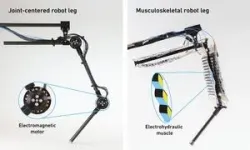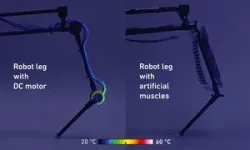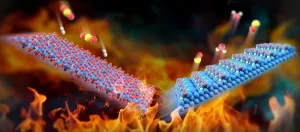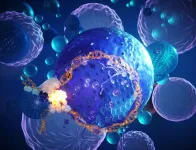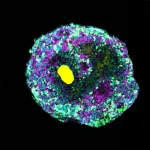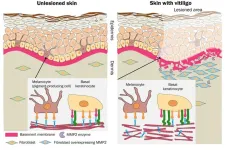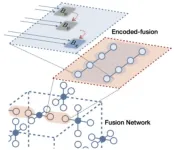(Press-News.org) Inventors and researchers have been developing robots for almost 70 years. To date, all the machines they have built – whether for factories or elsewhere – have had one thing in common: they are powered by motors, a technology that is already 200 years old. Even walking robots feature arms and legs that are powered by motors, not by muscles as in humans and animals. This in part suggests why they lack the mobility and adaptability of living creatures.
A new muscle-powered robotic leg is not only more energy efficient than a conventional one, it can also perform high jumps and fast movements as well as detect and react to obstacles – all without the need for complex sensors. The new leg has been developed by researchers at ETH Zurich and the Max Planck Institute for Intelligent Systems (MPI-IS) in a research partnership called Max Planck ETH Center for Learning Systems, known as CLS. The CLS team was led by Robert Katzschmann at ETH Zurich and Christoph Keplinger at MPI-IS. Their doctoral students Thomas Buchner and Toshihiko Fukushima are the co-first authors of the team’s publication on an animal-inspired musculoskeletal robotic leg in Nature Communications.
Electrically charged like a balloon
As in humans and animals, an extensor and a flexor muscle ensure that the robotic leg can move in both directions. These electro-hydraulic actuators, which the researchers call HASELs, are attached to the skeleton by tendons.
The actuators are oil-filled plastic bags, similar to those used to make ice cubes. About half of each bag is coated on either side with a black electrode made of a conductive material. Buchner explains that “as soon as we apply a voltage to the electrodes, they are attracted to each other due to static electricity. Similarly, when I rub a balloon against my head, my hair sticks to the balloon due to the same static electricity.” As one increases the voltage, the electrodes come closer and push the oil in the bag to one side, making the bag overall shorter.
Pairs of these actuators attached to a skeleton result in the same paired muscle movements as in living creatures: as one muscle shortens, its counterpart lengthens. The researchers use a computer code that communicates with high-voltage amplifiers to control which actuators contract, and which extend.
More efficient than electric motors
The researchers compared the energy efficiency of their robotic leg with that of a conventional robotic leg powered by an electric motor. Among other things, they analysed how much energy is unnecessarily converted into heat. “On the infrared image, it’s easy to see that the motorised leg consumes much more energy if, say, it has to hold a bent position,” Buchner says. The temperature in the electro-hydraulic leg, in contrast, remains the same. This is because the artificial muscle is electrostatic. “It’s like the example with the balloon and the hair, where the hair stays stuck to the balloon for quite a long time,” Buchner adds. “Typically, electric motor driven robots need heat management which requires additional heat sinks or fans for diffusing the heat to the air. Our system doesn’t require them,” Fukushima says.
Agile movement over uneven terrain
The robotic leg’s ability to jump is based on its ability to lift its own weight explosively. The researchers also showed that the robotic leg has a high degree of adaptability, which is particularly important for soft robotics. Only if the musculoskeletal system has sufficient elasticity can it adapt flexibly to the terrain in question. “It’s no different with living creatures. If we can’t bend our knees, for example, walking on an uneven surface becomes much more difficult,” Katzschmann says. “Just think of taking a step down from the pavement onto the road.”
In contrast to electric motors requiring sensors to constantly tell what angle the robotic leg is at, the artificial muscle adapts to suitable position through the interaction with the environment. This is driven just by two input signals: one to bend the joint and one to extend it. Fukushima explains: “Adapting to the terrain is a key aspect. When a person lands after jumping into the air, they don’t have to think in advance about whether they should bend their knees at a 90-degree or a 70-degree angle.” The same principle applies to the robotic leg’s musculoskeletal system: upon landing, the leg joint adaptively moves into a suitable angle depending on whether the surface is hard or soft.
Emerging technology opens up new possibilities
The research field of electrohydraulic actuators is still young, having emerged only around six years ago. “The field of robotics is making rapid progress with advanced controls and machine learning; in contrast, there has been much less progress with robotic hardware, which is equally important. This publication is a powerful reminder of how much potential for disruptive innovation comes from introducing new hardware concepts, like the use of artificial muscles”, Keplinger says. Katzschmann adds that electro-hydraulic actuators are unlikely to be used in heavy machinery on construction sites, but they do offer specific advantages over standard electric motors. This is particularly evident in applications such as grippers, where the movements have to be highly customised depending on whether the object being gripped is, for example, a ball, an egg or a tomato.
Katzschmann does have one reservation: “Compared to walking robots with electric motors, our system is still limited. The leg is currently attached to a rod, jumps in circles and can’t yet move freely.” Future work should overcome these limitations, opening the door to developing real walking robots with artificial muscles. He further elaborates: “If we combine the robotic leg in a quadruped robot or a humanoid robot with two legs, maybe one day, when it is battery-powered, we can deploy it as a rescue robot.”
END
Artificial muscles propel a robotic leg to walk and jump
2024-09-09
ELSE PRESS RELEASES FROM THIS DATE:
Researchers develop reaction-induced molybdenum carbides for efficient carbon dioxide conversion
2024-09-09
Molybdenum (Mo) carbides, known for their unique electronic and structural properties, are considered promising alternatives to noble metal catalysts in heterogeneous catalysis. However, traditional methods for preparing Mo carbides suffer from complex processes, stringent synthesis conditions, challenging crystal regulation, and high energy consumption. Additionally, Mo carbides are susceptible to oxidation and deactivation, which poses a significant barrier to their widespread application.
In a study published in Nature Chemistry, a research group led by Prof. SUN Jian from the Dalian Institute ...
Researchers identify factor that drives prostate cancer-causing genes
2024-09-09
For more information, contact:
Nicole Fawcett, nfawcett@umich.edu
EMBARGOED for release at 5 a.m. ET Sept. 9, 2024
Researchers identify factor that drives prostate cancer-causing genes
Factor previously known to play a role in advanced cancer is fundamental in early stages of cancer development
ANN ARBOR, Michigan — Researchers at the University of Michigan Health Rogel Cancer Center have uncovered a key reason why a typically normal protein goes awry and fuels ...
New molecular engineering technique allows for complex organoids
2024-09-09
A new molecular engineering technique can precisely influence the development of organoids. Microbeads made of specifically folded DNA are used to release growth factors or other signal molecules inside the tissue structures. This gives rise to considerably more complex organoids that imitate the respective tissues much better and have a more realistic cell mix than before. An interdisciplinary research team from the Cluster of Excellence “3D Matter Made to Order” with researchers based at the Centre for Organismal Studies and the Center ...
How the brain's inner chamber governs our state of consciousness
2024-09-09
In hospital operating rooms and intensive care units, propofol is a drug of choice, widely used to sedate patients for their comfort or render them fully unconscious for invasive procedures.
Propofol works quickly and is tolerated well by most patients when administered by an anesthesiologist. But what is happening inside the brain when patients are put under and what does this reveal about consciousness itself?
Investigators at U-M who are studying the nature of consciousness have successfully used the drug to identify the intricate brain geometry behind the unconscious state, offering an unprecedented ...
Can coping with a cancer diagnosis contribute to psychological and cardiovascular problems in family members?
2024-09-09
New research suggests that a family member’s cancer diagnosis may increase first-degree relatives’ and spouses’ risks of developing psychological and cardiovascular illnesses. The findings are published by Wiley online in CANCER, a peer-reviewed journal of the American Cancer Society.
Having a family member diagnosed with cancer can be a stressful and traumatic experience for the entire family. Because stress influences not only mental health but also cardiovascular health, investigators explored whether a cancer diagnosis contributes ...
Loss of skin’s pigment-producing cells could be related to basement membrane disruption
2024-09-09
Skin pigmentation disorders affect people across the world. One of them, vitiligo, is said to have a worldwide incidence of 1-2%. What causes the loss of pigmentation in vitiligo has long been unclear, but an Osaka Metropolitan University-led team has uncovered clues to the mechanism behind the disorder.
In findings published in The Journal of Pathology, Graduate School of Medicine Specially Appointed Associate Professor Lingli Yang, the corresponding author, and researchers including Specially Appointed Professor Ichiro ...
Developed proprietary quantum error correction technology beyond the world's leading quantum computing companies
2024-09-09
Solving the problem of error is essential for the practical application of quantum computing technologies that surpass the performance of digital computers. Information input into a qubit, the smallest unit of quantum computation, is quickly lost and error-prone. No matter how much we mitigate errors and improve the accuracy of qubit control, as the system size and computation scale increase, errors accumulate and algorithms become impossible to perform. Quantum error correction is a way to solve this problem. As the race for global supremacy in quantum technology intensifies, most major companies and research groups leading the development of quantum ...
AI will surpass human brains once we crack the ‘neural code’
2024-09-09
Humans will build Artificial Intelligence (AI) which surpasses our own capabilities once we crack the ‘neural code’, says an AI technology analyst.
Eitan Michael Azoff, a specialist in AI analysis, argues that humans are set to engineer superior intelligence with greater capacity and speed than our own brains.
What will unlock this leap in capability is understanding the ‘neural code’, he explains. That’s how the human brain encodes sensory information, and how it ...
RSV vaccination in older adults with health conditions is cost-effective
2024-09-09
Targeting vaccination programs for respiratory syncytial virus (RSV) to older adults with underlying health conditions is a cost-effective way to reduce disease, according to a new modelling study https://www.cmaj.ca/lookup/doi/10.1503/cmaj.240452 in CMAJ (Canadian Medical Association Journal).
RSV infections cause major illness, especially in infants and older adults, and rates of infection increase with age. There are now vaccines available to prevent disease caused by RSV in adults, and vaccination campaigns may reduce the incidence in older adults and associated ...
Melanoma incidence and mortality trends in Sweden
2024-09-09
About The Study: The findings of this cohort study showed a significant recent downward trend in both melanoma incidence and melanoma mortality in the age group 30 to 49 years in Sweden. The reasons for these declines are unclear but may include UV protection, public health campaigns, changing population demographics, and the introduction of effective melanoma treatment. None of these possibilities were evaluated; further study is needed.
Corresponding Author: To contact the corresponding author, Hildur Helgadottir, MD, PhD, email hildur.helgadottir@sll.se.
To access the embargoed study: Visit our For The Media ...

